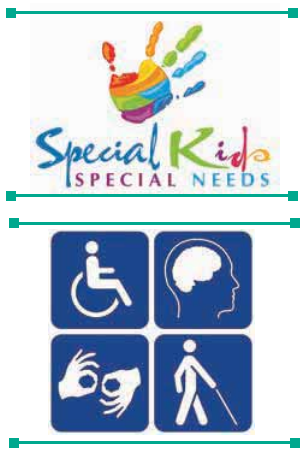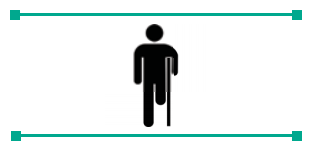Chapter: 11th Home Science : Chapter 2 : Human Development and its Challenges
Children with Special Needs - Domains and Stages of Development
Children With Special Needs
All children are ‘unique’ yet similar to one
another in most aspects of growth.

However, some children are very differ-ent
from their age-mates that they ‘stand out’. Such children have to deal with the
normal/usual problems of growth along with all those difficulties that may
arise because of being ‘different’. The child is unable to deal with the social
and emo-tional problems associated with it. This has marked effect on the
child’s personal and social development.
Normal Child and Disabled/ Disadvantaged Child
A normal healthy child is able to grow and do things to equip him/her for future life. A child who is not able to withstand the challenges of day-to-day life is generally referred to as handicapped/disabled or dis-advantaged children. They are also known as children who are ‘differently abled ’.
Baker, a well-known
psychologist defines the disabled
child as “one who deviates from what is supposed to be an average child in
physical, mental, emo-tional and social characteristics to such an extent that
the child requires special educational services to help develop to the maximum
capacity”.
Categories of Disabled/Disadvantaged
Children:
The disabled children can be broadly grouped
into three categories. These are:
i. Physically disabled
children.
ii. Mentally disadvantaged
children.
iii.
Socially maladjusted children.
Causes of Disability among Children:
The various causes of physical disability are
as follows:
·
Heredity
·
Unfavorable environment
·
Injury during child birth
·
Accidents during early childhood causing orthopedic problems.
·
Surgery requiring the amputation of the diseased part.
·
Mental and emotional problems in early childhood result in
stam-mering, stuttering and speech defects.
·
Ear infections and injuries result-ing in hearing defects.
·
Psychological, emotional problems and feelings of neglect result
in behavioural problems.
1. Visual Impairment:
Vision is a critical tool that children use in
obtaining information about the world in which they live. Impairment of vision
can lead to partial or total blindness. The children with visual impairment
will need special materials and attention to develop fully.
Causes of Visual Impairment
Visual impairment can be caused by the
following factors:
a. Congenital Blindness:
It refers to a child being born blind.
b. Acquired Blindness:
In this case the child is not born blind. The
child may lose eye-sight on account of some accident. The resulting eye-defect
is called acquired blindness.
c. Nutritional blindness:
It is a result of prolonged
absence of vitamin-A rich foods in the diet. Deficiency of vitamin-A causes
dryness of eyes, (xerophthalmia) and impaired vision in dim light (night
blindness).
Special Needs of a Visually Challenged Child:
Physical Needs:
Parents of a visually challenged children have
to give special attention and train their children to do their daily routine
jobs like toilet, bath, dressing and feeding etc. Special effort is needed to
help them to move around the house without knock-ing things and hurting
themselves.
Emotional and Social Needs:
Parents and siblings need to develop social
contact and provide constant reassurance by hugging, petting and reassuring the
handicapped child when scared and emo-tionally upset.
Educational Needs:
Books with big print and a desk with proper
light and recorded tapes are of considerable help to the child with defective
vision. The special tool called “Braille” is also helpful.
The Braille dots are punched out one at a time
from right to left. Children learn to use Braille with ease once coached
properly.
DO YOU KNOW?
White cane day is celebrated worldwide on
October 15th every year. This is cele-brated to create awareness and
celebrate the importance of the white cane used by visually challenged people.
2. Hearing Impairment
Definition
A child with hearing impairment is one who has
lost the sense of hearing before learning the language. This means that the
child is born without the ability to hear. Such children are often mute and
silent.
Hard of hearing on the other hand is
a defect that is acquired later in life. The child experiences varying degrees
of hearing loss.
Causes of hearing impairment
Hearing impairment and loss can be due to the
following factors:
(a) Conductive hearing impairment
The passage of air in the outer ear is called
the ’Conductive Pathway’. The conductive pathway can get affected due to
i. Build up of wax in the ear,
ii. A foreign body in the pathway iii. Any
swelling of the outer ear.
These conditions can cause temporary hearing
impairment that can be medically treated.
(b) Sensory Neutral
hearing loss is due to the damage of the ear drum, cochlea, auditory nerve and the
associated brain cells.
(c) Mixed Hearing Loss is a result of hearing impairments arising
due to a combination of conductive and sensory neural defects.
Characteristics of a Child with Hearing Impairment:
·
The child may be speech impaired besides having hearing
impairment.
·
They may have difficulty in learning language/vocabulary. It is
an enormous challenge to learn to communicate in a language one cannot hear.
Special Needs of a Child with Hearing Impairment
Hearing defects cause a lot of problems
ranging from language and vocabulary to comprehension and communication.
Physical needs can be effectively taken care of by providing physical comfort.
Parents can use play way techniques to help child.
Emotional and Social Needs:
Suspicion is almost the second nature with
deaf children. Their social behaviour also needs to be improved and refined.
Love and affection provide emotional security besides the much needed
encouragement for better learning.
Educational Needs involve child’s
ability to understand the language. They learn to communicate through
visual and manual means.
·
Oral Method or Lip-Reading is a slow method involving a lot of patience for the learner as well as
the educator.
·
Manual Method or Sign Language helps the child to
communicate with gestures, cues and finger-spellings.
3. Orthopedic Impairment
A child with an affected limb is not able to
fully perform the activities involving the use of bones, muscles and joints.
Similar handicap is experienced by children with a missing limb. Such children
are known to be orthopedically crippled.

Characteristics of A Child With Affected / Missing Limb
·
Physical defect leads to inferiority complex among young
children.
·
The feelings of inadequacy result in self-pity.
·
The child often goes through psycho-logical trauma because of
discrepancy between his/her aspirations and the ability to perform.
Special Needs of Children with Missing / Affected Limbs
Physical Needs consist of being able
to
cope with one’s daily routine. The attitude of parents should help the
child do his/her duties independently rather than “do things for them”. Use of
special contraptions like calipers, shoes and artificial limbs along with
proper training has yielded very good results. Use of crutches and wheel chair
improves the mobility besides boosting their confidence.
Social and Emotional Needs. Children with affected
limbs are very often left out of social group activities. The child may feel
frustrated, dejected and neglected. Loving care and proper training to be
independent and self-reliant are the basic needs of all handicapped children.
Educational Needs involve and include
such activities that require ‘doing’. Writing, playing, drawing, painting,
knitting and even dancing are some much activities.
4. Children with Impaired Speech
The main purpose of speech is effective
communication. When speech is defective communication is also defective.
Causes of Speech Defects
There are many causes for speech defects.
They are as follows:
i.
Physiological causes: Defects and deformities of the larynx and the vocal cords affect the speech
pro-duced. Incomplete development of the skull and head produces a cleft palate
and cleft lip which produce speech defects
ii.
Neurological causes. When nerves connected with the areas of speech and learning process are
impaired, some type of speech defect or dis-order of articulation occurs
iii.
Psychogenic Causes. These are causes related to one’s mind. Some types of stuttering are
purely psy-chogenic in origin. General self consciousness added with speech
defect may produce stuttering.
iv.
Sociological causes. Some speech habits such as too rapid or too slow speech, or speaking
in the low tones insisted by the parent may lead to speech defects.
Special need of children with speech defects
Physical needs
Surgery can correct some of the physiogenic
causes like cleft palate, extremely enlarged tonsils, adenoids, etc. Motor
activities, dramatic play of all kinds, excursions, discussing and planning
group activities will help in developing correct speech patterns.
Educational Needs
Classes under special teachers will be use-ful
for correction of pronunciation
Emotional needs
Children should be given opportunities to
listen to stories. The teacher and par-ents should always make it a point to
pro-nounce words clearly themselves.
5. Mentally Challenged Children
The intelligence possessed by a normal
individual is said to be between 90 and 110 I.Q. Some children possess less
than average intelligence and they are said to be mentally challenged or
mentally handicapped.
Meaning of I.Q.
The letters IQ stand for Intelligence
Quotient. It is a measure of intelligence. The formula used to calculate the
I.Q. is MA/CA x100. MA stands for Mental Age and CA stands for
Chronological Age. The mental age of a person is found out by intelligence
tests. If the mental age corre-sponds with his chronological age or the
physical age, then his mental growth is said to be normal. The mentally
retarded children have a lower mental age than their chronological age.
Classification of mentally challenged people
Depending on the I.Q possessed, mentally
challenged people/children are classi-fied as slow learners, challenged,
moder-ately challenged and severely challenged.
Children who are mildly retarded are referred
to as educable. Those who are moderately challenged are called train-able.
Those who are severely and pro-foundly challenged are called totally dependent.
The characteristics of mentally challenged children
a. Physical traits- For majority of them,
their height and weight is normal for their respective ages. Muscular control
is fairly well developed. Senses are well devel-oped but occurrence of speech
defects such as stammering and lisping is fairly large among these children.
b. Other traits- Socially they are found to be
less adjustable. Vocab-ulary is very much limited. They find adjustment to new
situations difficult.
Causes of Mental Challenges in Individuals
The causes may be endogenous or exogenous.
Endogenous type mainly consists of hereditary conditions. Defect in the germ cell produces a
retarded condition called microcephaly. Defects in the nerv-ous system and
weaker nerve potential inherited also lead to mental challenges. Marriage
between men and women who are close blood relatives is said to lead to mental
challenges in their children.
Exogenous causes for mental challenges includes venereal diseases in the mother, brain
injury at birth and var-ious forms of anoxia at the time of birth. Toxic
conditions in older mothers during pregnancy causes mongolism. Thyroid
deficiency in children causes cretinism or dwarfism. Brain injury due to
acci-dents, brain fever in the new born, also lead to mental challenges after
birth.
Needs of Mentally challenged Children.
Proper prenatal care including immuni-zation,
good diet, and medical check-up delivery attended by a trained person,
preferably hospital delivery and proper weaning foods for the baby will reduce
the incidence of individual attention and instruction. In the case of slow
learners they need more help and stimulation. The teacher needs to give clear
direction and encouragement. The learning process must be made simple and more
of con-crete examples must be used.
Related Topics